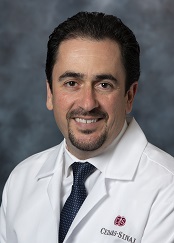Cedars-Sinai Blog
Supporting Homeless Patients in the Emergency Room
Aug 19, 2022 Victoria Pelham

Weihao Qu and Yasmin Mendez Trejo, community resource coordinators in Cedars-Sinai Marina Hospital and Cedars-Sinai's emergency rooms, help patients experiencing homelessness.
Every day, community resource coordinators in the Cedars-Sinai emergency room swoop in to tend to the pressing needs of patients experiencing homelessness, supplying them with warm meals, showers and long-needed prescriptions.
The two coordinators, who can see up to 20 unhoused patients over the course of a daily shift, attempt to triage the Los Angeles homelessness crisis from inside the hospital—and link their patients to care and support beyond its walls.
"It became very apparent to us that if we want to help people, we can't just look at a medical model and look away: We need to develop more social support."
Here to help
With an emphasis on treating the whole person, the Agents of Health Program is part of a larger Cedars-Sinai effort to address the social and psychological factors that influence health, such as safe housing and living environments, consistent food access, and health literacy and coverage. Providers hope the strategy will increase the flow of patients to better-suited environments, collect data to more closely track the situation and put the unhoused on a path to long-term, comprehensive recovery.
"We are here to help people," says Dr. Sam Torbati, medical director of the Ruth and Harry Roman Emergency Department at Cedars-Sinai. "Sometimes that help requires a procedure or a medication. With certain underserved patients, the help they need is beyond what we can do as clinicians."
"It became very apparent to us that if we want to help people, we cannot just look at a medical model and look away: We need to develop more comprehensive social support."

Sam S. Torbati, MD
Sam S. Torbati, MD
Mobilizing a "warm handoff"
Cedars-Sinai's emergency room coordinators support discharging patients who self-identify as homeless, do not have a permanent address or are flagged by staff through patient history.
After delivery of any emergency medical treatment, unhoused and underserved patients are offered:
- Basic material and hygiene provisions, such as clean, weather-appropriate clothing
- Medications, if necessary. Cedars-Sinai doctors will write the prescriptions, and on-site pharmacists and navigators fill them before discharge.
- Needed durable medical equipment, such as canes, crutches, splints or wheelchairs
- Infectious disease screening, such as for COVID-19 and hepatitis, depending on current outbreaks among the local homeless population. "We know these patients can't just walk into other environments and ask to be tested," Dr. Torbati notes.
- Vaccination to prevent spread of communicable diseases, including COVID-19
- Health insurance enrollment
- Medical and mental health referrals to community facilities, such as the Saban Community Clinic, for follow-up primary, dental and behavioral healthcare, including substance-use treatment
- Housing and shelter referrals
- Post-discharge transportation
Navigators are experienced in providing care and wraparound support to patients without stable housing—and they understand the deep, unique challenges these patients face, says Claude Stang, executive director of Emergency Services at Cedars-Sinai.
Those involved prioritize a "warm handoff"—whether that's lining up schedules to see a local clinic doctor on the same day as discharge or simply ensuring the patient understands how often to take a new medication.
"Navigating after a hospital visit with no support can be really challenging," Stang says. "We know it may be difficult for that person just to get through their day."
A community in crisis
About 66,500 people experienced homelessness in Los Angeles County in January 2020, an almost 13% jump from the previous year, according to the Los Angeles Homeless Services Authority (LAHSA). Although LAHSA skipped its annual count in 2021 as a safety precaution, that figure likely rose with the economic effects of COVID-19.
Cedars-Sinai's emergency room saw its number of patients experiencing homelessness skyrocket alongside that regional spike, just as its homeless navigator program was getting under way. Cedars-Sinai established the program in October 2019.
"Hospitals serve as a safety net and key gateway into care for community members in need," Dr. Torbati says. "If we do not help them when they arrive, we don't know when their next chance will come."
Signs of promise
Homelessness isn't the primary issue for many chronically unsheltered patients, Dr. Torbati points out. Many suffer from mental health and substance-use disorders, often untreated, while also facing obstacles such as food insecurity and disability.
Nearly two-thirds of chronically homeless Los Angeles County residents have a mental illness, with roughly half struggling with substance use, according to the L.A. County Department of Public Health. The vast majority (about 80%) had not received any treatment in the prior 60 days.
You must deal with these root causes to make any meaningful change, he stresses.
"Trying to reverse that trajectory in the entire life of an individual experiencing homelessness—who took months or years to get there—is typically not very quick," says Dr. Torbati. "It takes a lot of effort and focus."
But early findings suggest the approach might be working: Patients who saw a community resource coordinator stabilized and came back to the department less frequently, equating to between 4.5 and 15.7 extra days between emergency visits over the course of a year.
"We are helping folks get back on their feet and for a longer period of time," Stang explains.
Building a new care model
Emergency room directors point to face-to-face communication as one reason for the program's early success. Coordinators are dedicated experts in this space. They know how to speak with wary patients in a way that establishes trust and rapport, encouraging them to continue care.
They are also able to go beyond the confines and bandwidth of existing social worker roles to help patients navigate the system after hospital discharge, Dr. Torbati notes. Because you often can't just pick up a phone to reach an unhoused patient who has left, oversight goes a long way.
With the recent addition of similar community health workers for underserved patients who are not homeless, leaders expect the program to continue to grow and expand throughout the hospital to reach different vulnerable groups, like older adults and beyond. Outside experts are also seeking to replicate the data analysis model to improve homeless care.


